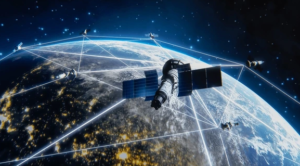Transmitting data by laser is being touted as the next big advancement of technology; at what cost to health?
Alphabet, Google’s parent company, is spinning off its laser-based internet company, Taara, from its “moonshot” experimental hub, X, to provide high-bandwidth services to hard-to-reach rural areas and compete with Elon Musk’s Starlink network of satellites.

Taara originated from the concept called Loon, which aimed to provide phone and internet services across remote areas using beams of light between thousands of balloons floating on the edge of space, but was wound up in 2021 due to regulatory hurdles and technical difficulties.
However, its lasers found a second life on Taara’s towers under engineer and general manager Mahesh Krishnaswamy, Financial Times reports. He says that the company’s technology can offer 10 to 100 times more bandwidth to end users than a typical Starlink antenna, and at a fraction of the cost, making it a competitive alternative for connecting rural areas to the internet.
The company’s technology works by firing a beam of light the width of a pencil from one terminal to another, using a system of sensors, optics and mirrors to transmit data at 20 gigabits per second over 20 km, extending traditional fibre-optics networks with minimal construction and lower costs.
The start-up already operates in 12 countries, including India and parts of Africa, and has created a 5 km laser link over the Congo River, supplementing overloaded mobile phone networks at events such as the Coachella music festival in California.
Krishnaswamy says the next stage of development is a tiny silicon photonic chip that will obviate the need for many of the terminals’ mirrors and lenses and allow multiple connections from one transmitter, potentially replacing radio-based Wi-Fi networks in offices.
The company has a long way to go before it can compete with SpaceX’s Starlink, which generated an estimated $9.3 billion in revenue from 4.7 million subscribers last year. However, Taara partners with large telecommunication companies to extend their core fibre-optic networks to far-flung locations or dense urban areas.
According to Eric “Astro” Teller, X’s captain of moonshots, and Mahesh Krishnaswamy, Taara has numerous technological advantages over Starlink, including the ability to transmit data via light, which can criss-cross without interference and does not require politicised auctions of radio spectrum.
Teller believes that as more people come online, the world will run out of traditional radio frequency bands and will have to shift even further up the electromagnetic spectrum, putting Taara in a strong position as a pioneer in the field of light-based data transmission.
There’s one big issue that proponents of laser-transmitted data are not discussing and no one seems to be considering: What will the ill effects of firing thousands of lasers be on humans, plants, animals, the environment and ultimately our world?
A quick search on the internet, and without digging into any of the details, reveals that lasers can cause various health effects, primarily through thermal, acoustical and photochemical processes.
Thermal effects occur when laser energy is absorbed by tissue, causing a temperature rise. Acoustical effects result from a mechanical shockwave propagated through tissue, which can damage tissue when the laser beam causes localised vaporisation, similar to ripples in water from throwing a rock into a pond.
Photochemical effects can also occur when photons interact with tissue cells, potentially causing a change in cell chemistry that may result in damage or changes to tissue. These photochemical effects depend greatly on the wavelength of the laser.
Laser exposure can lead to eye injuries, including retinal burns and cataracts, as well as skin injuries such as burns and pigment darkening. The severity of these injuries depends on factors like exposure duration, wavelength, energy of the beam and the area and type of tissue exposed.
Lasers can also cause non-beam-related hazards, such as electrical and chemical hazards, which can result in serious personal injury or death.
Sources and resources:
- Alphabet spins off laser-based internet project from ‘moonshot’ hub, Financial Times, March 17, 2025
- Alphabet spins off Starlink competitor Taara, The Verge, March 17, 2025
- Alphabet spins off laser-based Internet backbone provider Taara, ARS Technica, March 17, 2025
- Evaluation of Laser Effects on the Human Body After Laser Therapy, PubMed, January 18, 2020
- Section 2: Laser Hazards, Princeton University Environmental Health Safety
- Laser Safety Program: Biological Effects of Laser Radiation, US San Diego, October 27, 2020
- Laser Bio-Effects and Hazards, Weill Cornell Medicine
- Lasers – Health Care, Canadian Centre for Occupational Health and Safety
- Laser hazards and safety, Australian Radiation Protection and Nuclear Safety Agency
yogaesoteric
March 26, 2025
